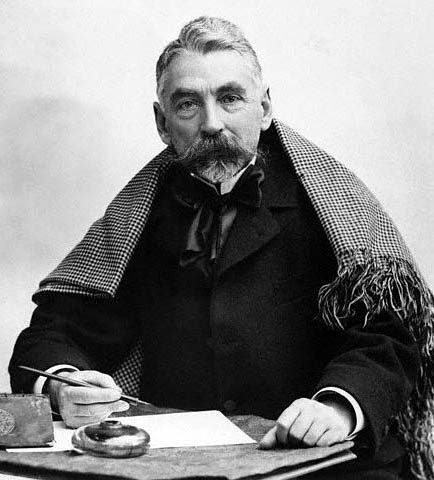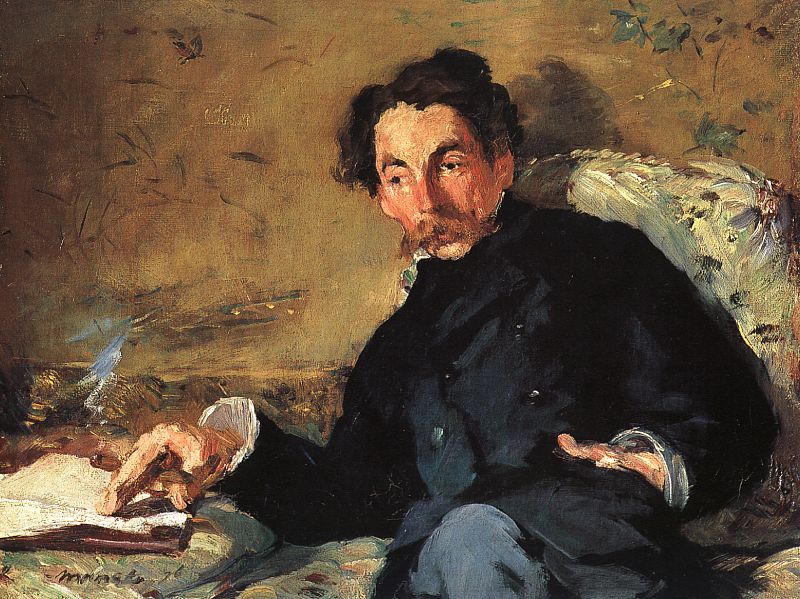<Back to Index>
- Mathematician Christian Goldbach, 1690
- Poet Stéphane Mallarmé, 1842
- Prime Minister of the United Kingdom Arthur Neville Chamberlain, 1869
PAGE SPONSOR


Stéphane Mallarmé (18 March 1842 – 9 September 1898), whose real name was Étienne Mallarmé, was a French poet and critic. He was a major French symbolist poet, and his work anticipated and inspired several revolutionary artistic schools of the early 20th century, such as Dadaism, Surrealism, and Futurism.
Stéphane Mallarmé was born in Paris. He worked as an English teacher and spent much of his life in relative poverty; but was famed for his salons, occasional gatherings of intellectuals at his house on the rue de Rome for discussions of poetry, art, philosophy. The group became known as les Mardistes, because they met on Tuesdays (in French, mardi), and through it Mallarmé exerted considerable influence on the work of a generation of writers. For many years, those sessions, where Mallarmé held court as judge, jester, and king, were considered the heart of Paris intellectual life. Regular visitors included W.B. Yeats, Rainer Maria Rilke, Paul Valéry, Stefan George, Paul Verlaine, and many more.
On
10 August 1863, he married Maria Christina Gerhard. Their daughter,
(Stéphanie Françoise) Geneviève Mallarmé,
was born on 19 November 1864. He died in Valvin, Vulaines-sur-Seine in 1898. Mallarmé's earlier work owes a great deal to the style of Charles Baudelaire. His later fin de siècle style,
on the other hand, anticipates many of the fusions between poetry and
the other arts that were to blossom in the next century. Most of this
later work explored the relationship between content and form, between
the text and the arrangement of words and spaces on the page. This is
particularly evident in his last major poem, Un coup de dés jamais n'abolira le hasard ('A roll of the dice will never abolish chance') of 1897. Some consider Mallarmé one of the French poets most difficult to translate into English.
The difficulty is due in part to the complex, multilayered nature of
much of his work, but also to the important role that the sound of the
words, rather than their meaning, plays in his poetry. When recited in
French, his poems allow alternative meanings which are not evident on
reading the work on the page. For example, Mallarmé's Sonnet en '-yx' opens with the phrase ses purs ongles ('her pure nails'), whose first syllables when spoken aloud sound very similar to the words c'est pur son ('it's pure sound'). Indeed, the 'pure sound' aspect of his poetry has been the subject of musical analysis and has inspired musical compositions. These phonetic ambiguities are very difficult to reproduce in a translation which must be faithful to the meaning of the words.
Mallarmé's poetry has been the inspiration for several musical pieces, notably Claude Debussy's Prélude à l'après-midi d'un faune (1894), a free interpretation of Mallarmé's poem L'après-midi d'un faune (1876), which creates powerful impressions by the use of striking but isolated phrases. Maurice Ravel set Mallarmé's poetry to music in Trois poèmes de Stéphane Mallarmé (1913). Other composers to use his poetry in song include Darius Milhaud (Chansons bas de Stéphane Mallarmé, 1917) and Pierre Boulez (Pli selon pli, 1957 - 62). Man Ray's last film, entitled Les Mystères du Château de Dé (The Mystery of the Chateau of Dice) (1929),
was greatly influenced by Mallarmé's work, prominently featuring
the line "A roll of the dice will never abolish chance". Mallarmé is referred to extensively in the latter section of Joris-Karl Huysmans' À rebours,
where Des Esseintes describes his fervour - infused enthusiasm for the
poet: "These were Mallarmé's masterpieces and also ranked among
the masterpieces of prose poetry, for they combined a style so
magnificently that in itself it was as soothing as a melancholy
incantation, an intoxicating melody, with irresistibly suggestive
thoughts, the soul-throbs of a sensitive artist whose quivering nerves
vibrate with an intensity that fills you with a painful ecstasy." It has been suggested by some that much of Mallarmé's work influenced the conception of hypertext,
with his purposeful use of blank space and careful placement of words
on the page, allowing multiple non-linear readings of the text. This
becomes very apparent in his work Un coup de dés. Prior
to 2004, "Un Coup de Dés" was never published in the typography
and format conceived by Mallarmé. In 2004, 90 copies on vellum
of a new edition were published by Michel Pierson et Ptyx. This edition
reconstructs the typography originally designed by Mallarmé for
the projected Vollard edition in 1897 and which was abandoned after the
sudden death of the author in 1898. All the pages are printed in the
format (38cm by 28cm) and in the typography chosen by the author. The
reconstruction has been made from the proofs which are kept in the
Bibliothèque Nationale of France, taking into account the
written corrections and wishes of Mallarmé and correcting
certain errors on the part of the printers Firmin-Didot. A
copy of this new edition can be consulted in the Bibliothèque
François Mitterrand. Copies have been acquired by the
Bibliothèque littéraire Jacques Doucet and University of
California - Irvine, as well as by private collectors. A copy has been
placed in the Museum Stéphane Mallarmé at
Vulaines-sur-Seine, Valvins, where Mallarmé lived and died and
where, according to Paul Valéry, he made his final corrections
on the proofs prior to the projected printing of the poem. The poet and visual artist Marcel Broodthaers created a purely graphical version of Un coup de Dés, using Mallarmé's typographical layout but with the words replaced by black bars.